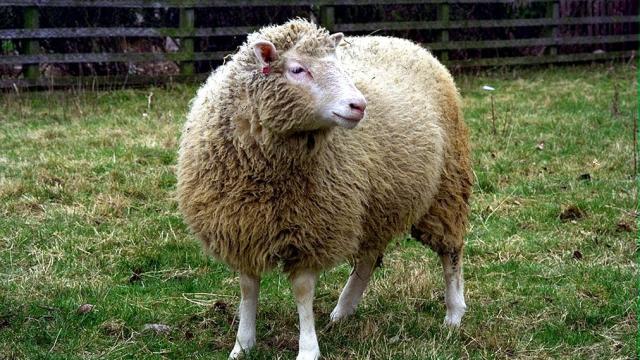Dolly the Sheep made biotech history in 1996 when she became the first animal cloned from adult somatic cells. She lived to the age of seven, which is young for sheep, leading scientists to speculate that her premature death had something to do with her being a clone. New research now shows this wasn’t the case.
This whole story can be traced back to a single conference abstract that made brief mention of osteoarthritis in Dolly’s left knee which appeared when she was just five-and-a-half years old. Sheep typically live to be about 10 or 12, so when Dolly died before the age of seven, scientists figured her premature death — and the early onset arthritis — were somehow related to animal cloning. And in fact, it was soon taken for granted that a consequence of cloning was an early grave.
New research published in Scientific Reports now debunks these early suspicions, showing that Dolly’s health complications were not the result of cloning, and that Dolly’s worn out joints weren’t anything out of the ordinary.
Biologists started to suspect this was the case last year following a study of four eight-year old ewes produced from the same clonal line as Dolly. The researchers uncovered evidence of mild osteoarthritis in three of the sheep, and moderate osteoarthritis in one. Examination of these animals, known as the “Nottingham Dollies,” suggested these particular clones aged normally, and that Dolly must’ve been some kind of anomaly.
But the scientists weren’t content to stop there.
“Our findings of last year appeared to be at odds with original concerns surrounding the nature and extent of osteoarthritis in Dolly — who was perceived to have aged prematurely,” Kevin Sinclair, lead author of the new paper and professor of developmental biology at the University of Nottingham, said in a statement. “Yet no formal, comprehensive assessment of osteoarthritis in Dolly was ever undertaken. We therefore felt it necessary to set the record straight.”
Because no original clinical or radiographic records were kept of Dolly, the researchers had to perform a radiographic exam (a kind of X-ray) on Dolly’s skeleton, which is kept in the collections of National Museums Scotland in Edinburgh. Sinclair’s team also examined the bones belonging to Bonnie (Dolly’s naturally conceived daughter), and Megan and Morag (the first two animals to be clones from differentiated cells, or pluripotent stem cells).
Results showed that osteoarthritis was more severe in these older sheep compared to Dolly. What’s more, Dolly exhibited no obvious signs of osteoarthritis in her shoulder, carpal, or hock joints when she was six years old. The overall distribution of osteoarthritis in Dolly was similar to what’s seen in cloned sheep aged seven to nine.
“We found that the prevalence and distribution of [osteoarthritis as detected via radiographic scans] was similar to that observed in naturally conceived sheep, and our healthy aged cloned sheep,” said University of Glasgow professor Sandra Corr, a co-author of the study. “As a result, we conclude that the original concerns that cloning had caused early-onset [osteoarthritis] in Dolly were unfounded.”
Dolly was euthanised in 2003 because she had a form of lung cancer, which is fairly common among sheep.
